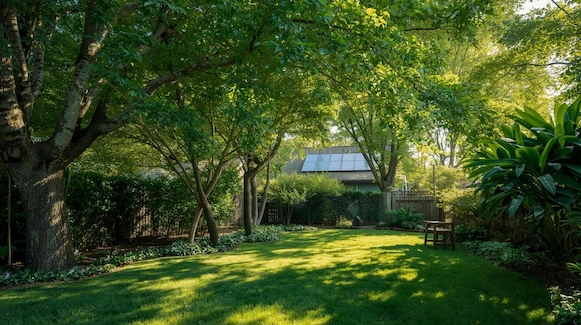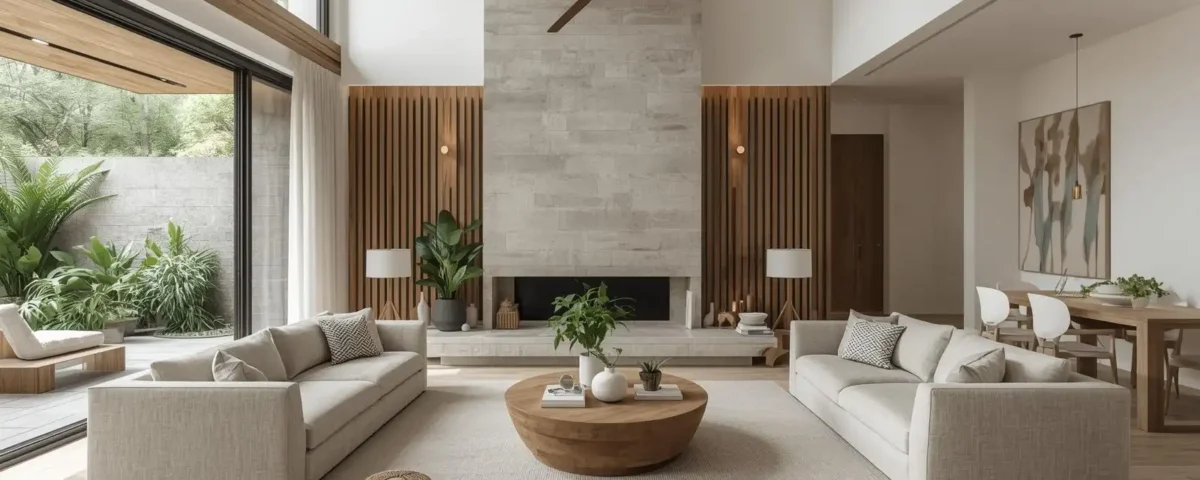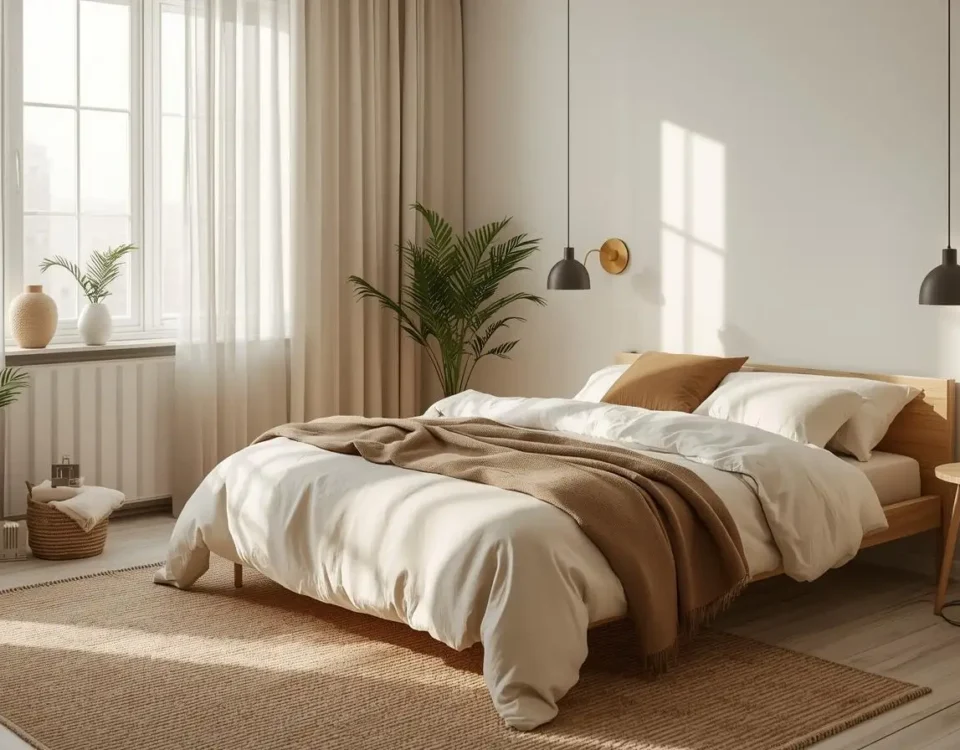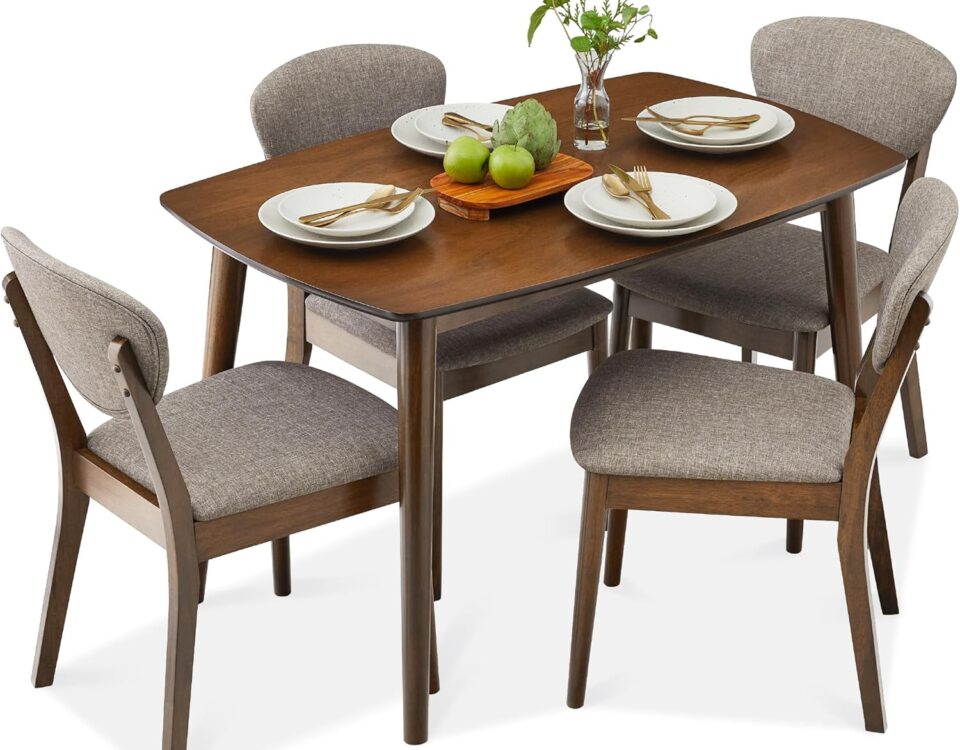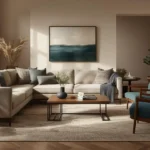
Room & Board Furniture Review: An Honest Look at Quality, Value, and Real Customer Experiences
September 10, 2025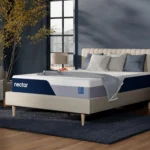
Mattress Types Compared: Foam vs. Innerspring vs. Hybrid – Ultimate Buyer’s Guide to Better Sleep
September 16, 2025Are you dreaming of a living space that feels both effortlessly chic and deeply calming?
Picture this: you walk into your living room and instantly feel a sense of peace. Soft, neutral tones soothe your senses. Natural textures like warm wood, stone, and linen ground the space. The design is clean and uncluttered, but far from cold. Every detail feels intentional. This is the essence of Organic Modern design.
Welcome to the world of Organic Modern living where minimalist elegance meets the beauty of nature.
This design philosophy artfully combines the simplicity of modern interiors with the warmth and soul of organic elements. Think curated spaces that feel airy and open, yet lived-in and comforting. If you've ever wanted a home that feels like a calm retreat without sacrificing style, this guide is for you.
In this definitive guide, we’ll walk you through the transformation of a living room into an Organic Modern haven.
You’ll not only see how this look comes to life step by step but also gain the tools to do it yourself. From the foundational principles behind the style to actionable tips and a curated selection of must-have pieces, this guide has everything you need to confidently create a space that’s as serene as it is stylish.
Why trust this guide?
The team crafts it at [Homes and Looms Team ] experienced interior designers who specialize in blending functionality with aesthetics. Our work has helped countless clients transform their homes into spaces that reflect both who they are and how they want to live. Curious to see more? Check out our Portfolio for real-life examples of our Organic Modern designs in action.
Understanding the Organic Modern Aesthetic
What is Organic Modern Design?
Organic Modern design is where simplicity meets soul. At its core, this style is a thoughtful blend of contemporary minimalism and nature-inspired warmth. It’s the art of creating clean, sleek interiors that never feel cold or clinical because they’re balanced with organic materials, earthy textures, and a calming atmosphere.
It’s more than just a visual style; it’s a philosophy of living. Each piece, each material, and each open space plays a role in shaping a room that not only looks beautiful but feels grounded and intentional.
The Core Philosophy of Organic Modern Design
- Serenity & Calm: Every aspect of the space is curated to create a tranquil, restful environment. It’s design as a form of wellness.
- Connection to Nature: Natural materials and forms bring a sense of the outdoors inside, connecting you to the earth even when you’re relaxing on the couch.
- Timeless Appeal: With its reliance on natural elements and minimalist structure, Organic Modern avoids fleeting trends, ensuring your space remains stylish for years to come.
- Functionality: It’s not just about beauty it’s about livability. Organic Modern design considers how you actually use your space, combining form and function in harmony.
Why It’s a Popular Choice
People are drawn to Organic Modern interiors because they feel like a breath of fresh air. In a world that often feels chaotic and overstimulating, this design style offers calm, clarity, and comfort. It’s versatile enough to suit different lifestyles and architectural settings, yet distinct enough to make a statement. That ability to feel both current and classic is what makes it so appealing for today’s homes.
Core Principles of Organic Modern Design
1. Natural Materials & Textures
Natural materials are the backbone of the Organic Modern look. Think wood, stone, linen, wool, jute, rattan, and clay materials that age gracefully and add soul to a space.
💡 Expert Tip: Layer textures generously. Try combining a linen sofa with a chunky knit throw, a jute rug, and a wooden coffee table to create dimension and tactile interest without the need for loud colors.
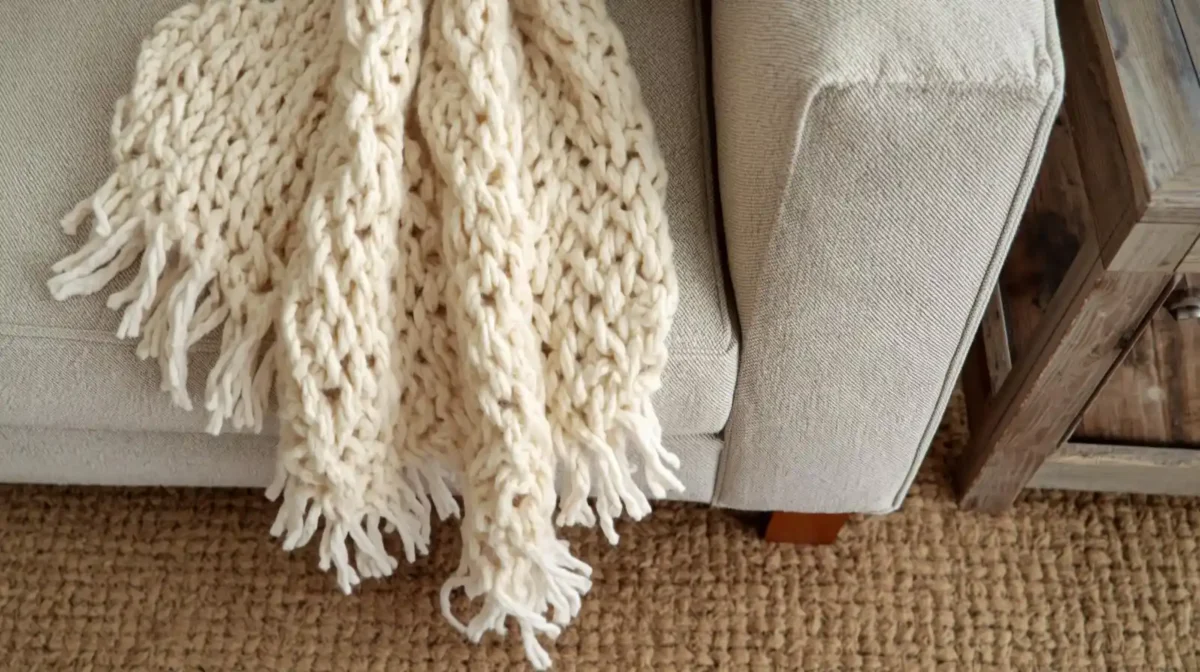
Neutral Color Palettes
Organic Modern spaces thrive on soft, muted tones. You’ll often find a base of whites, creams, warm grays, and earthy shades like terracotta, beige, or olive green.

3. Clean Lines & Minimalist Forms
Furniture and decor in this style favor simple, elegant shapes. There’s a sense of refinement without excess everything serves a purpose and nothing feels overdone.
The goal is understated elegance. Think sleek, low-profile furniture, unembellished light fixtures, and open layouts that let your materials and textures shine.
4. Biophilic Design
At the heart of Organic Modern is biophilic design a concept focused on enhancing our connection to nature through design.

Plants don’t just decorate the space they clean the air, soften hard lines, and bring vitality into the room.
5. Embracing Imperfection
Organic Modern isn’t about perfection it’s about character. The unique irregularities of a hand-thrown ceramic bowl or the rough edges of a live-edge wood bench tell a story that machine-made items never could.

Examples to Include:
- Live-edge wood dining tables
- Handcrafted pottery with visible texture
- Woven seagrass baskets
6. Negative Space & Openness
In Organic Modern design, what you leave out is just as important as what you put in. The space needs to breathe.

7. Light & Airiness
Light is essential to this style particularly natural light. It lifts the space, highlights textures, and enhances the feeling of openness.

The Living Room Revealed: A Journey into Organic Modern Design
Before & After: A Visual Transformation
Every great design story begins with a vision and sometimes, a challenge. In this Organic Modern transformation, a previously dated and disjointed living room is reimagined as a serene, cohesive sanctuary. The difference is not only visible it’s deeply felt.
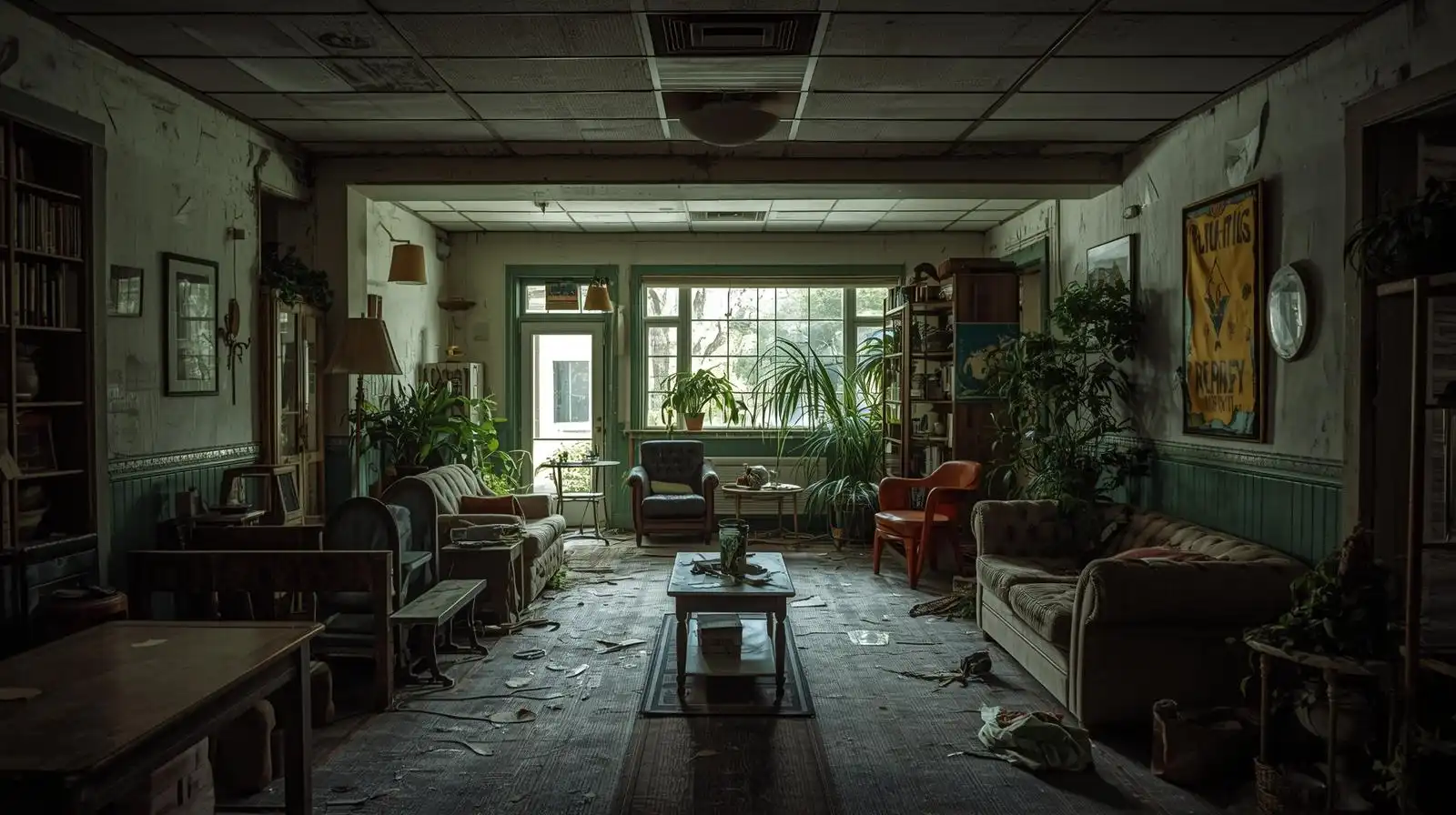
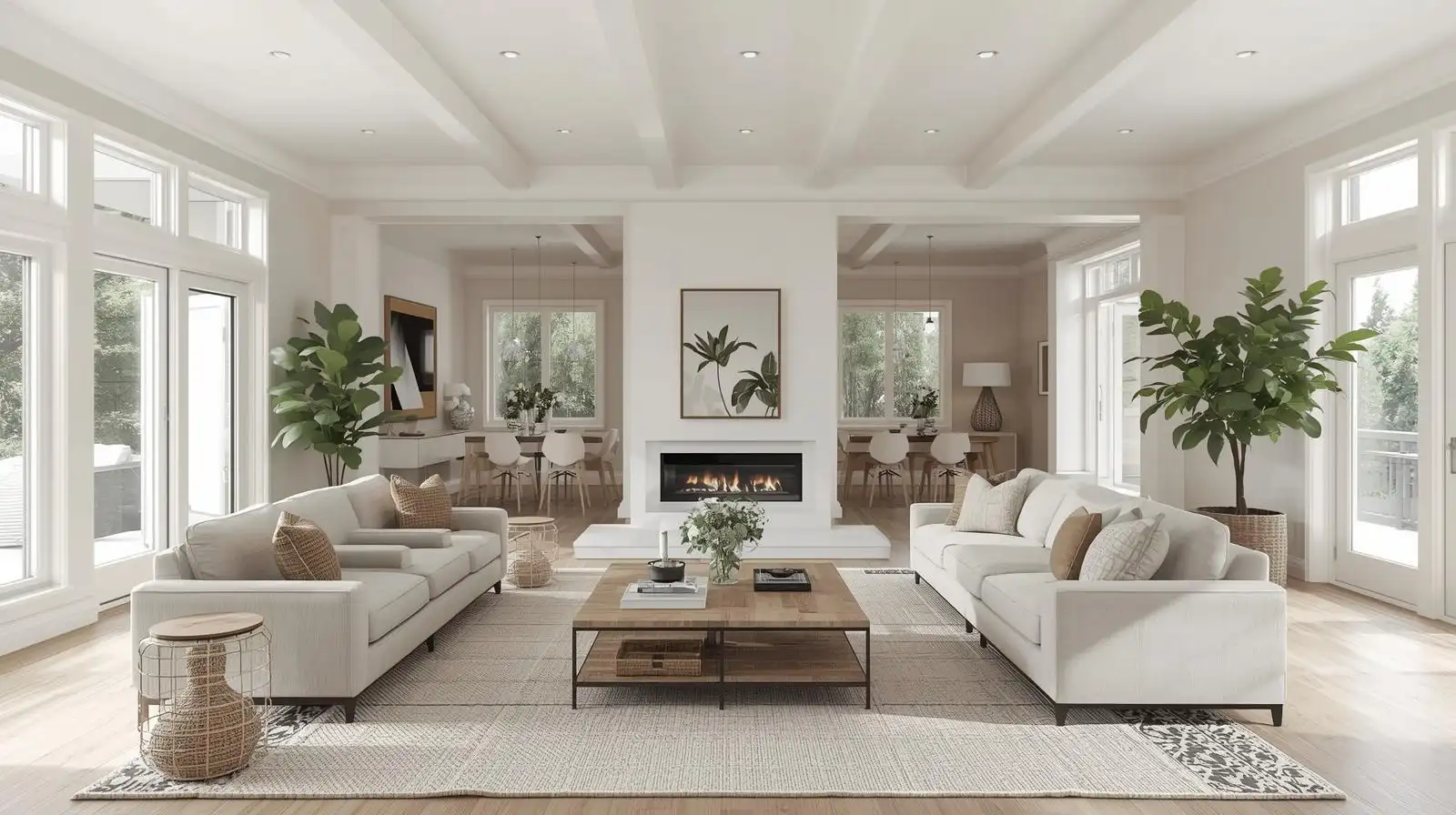
The Vision: Conceptualizing the Organic Modern Aesthetic
The goal from the beginning was clear: create a space that feels clean yet cozy, minimal but full of soul. The design team leaned heavily into the Organic Modern philosophy choosing natural textures, grounding hues, and an emphasis on light and flow.
The homeowner wanted a living room that could function as a daily retreat and a stylish space for entertaining guests without ever feeling stiff or overly styled. This balance became the foundation of every design decision.
The Journey: Highlights of the Design Process
The transformation unfolded in thoughtful phases:
- Decluttering was the first step removing outdated decor and furniture that didn’t serve the space.
- Structural improvements were made to maximize natural light and improve layout flow.
- Material selections focused on timeless pieces: soft linens, warm wood, subtle ceramics.
- Strategic layering of textiles and lighting brought depth, comfort, and flexibility to the room.
Each decision no matter how small was guided by the question: Does this make the space feel more grounded, more calm, and more connected to nature?
The Impact: A Dramatic Shift in Mood & Functionality
The change goes far beyond aesthetics. Where once the room felt fragmented and underutilized, it now flows effortlessly inviting conversation, relaxation, and connection. The space feels lighter, both visually and emotionally, with intentional elements that make it feel curated but lived-in.
Deconstructing the Design: Elements & Placement Strategy
Understanding the Layout
One of the biggest challenges was making the open-concept layout feel purposeful. Without walls to define the living room, strategic furniture placement was essential to ground the space and guide movement.
💡 Expert Tip: Use larger anchor pieces to define the perimeter of your “room” within an open layout, and place smaller pieces to encourage natural gathering zones.
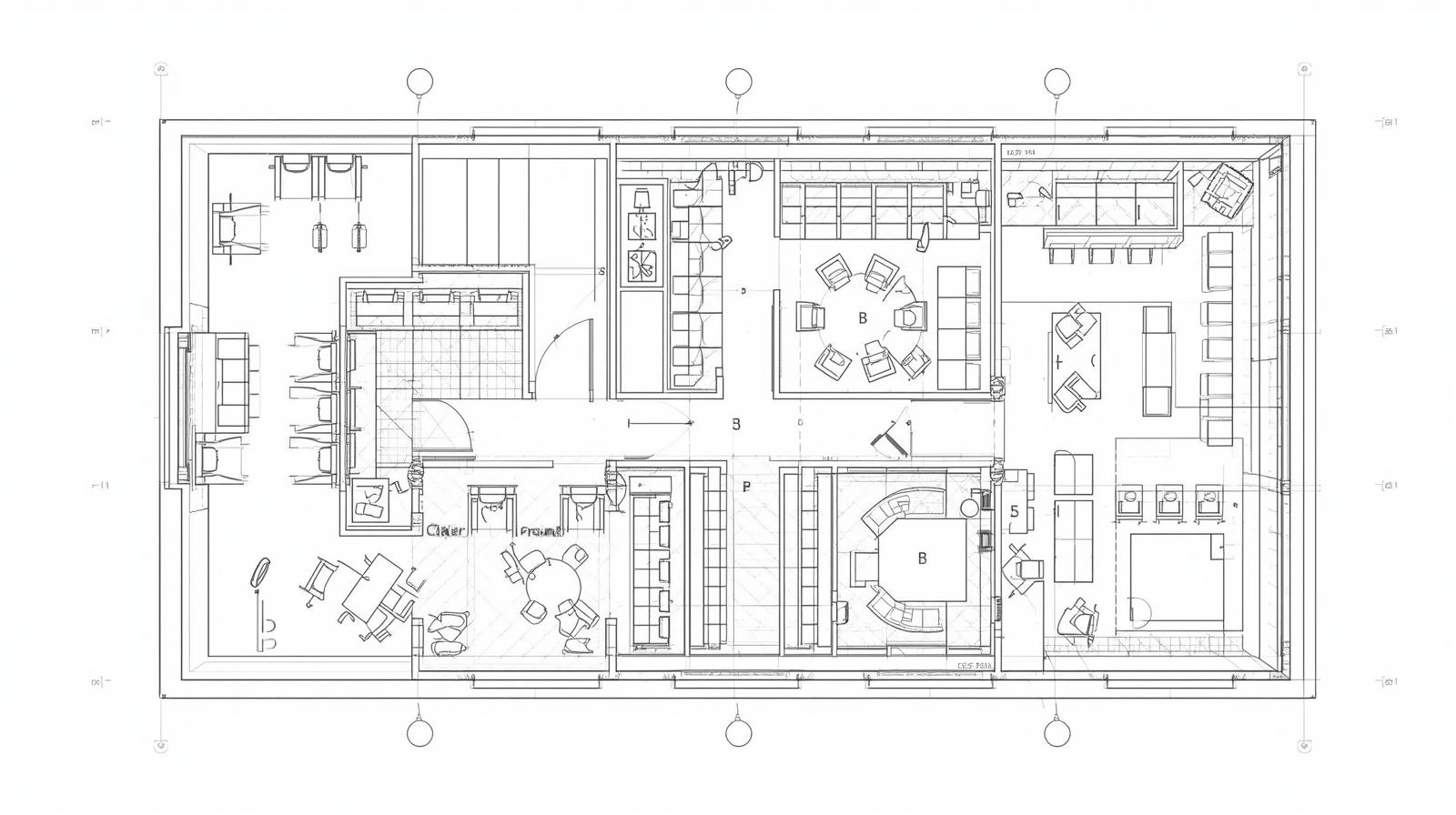
Anchor Pieces
Quality over quantity defined this phase. The linen-upholstered sofa became the heart of the room chosen for its clean silhouette, soft texture, and neutral tone. Paired with a light oak coffee table and a low-profile media console, the layout remains minimal yet welcoming.
💡 Expert Tip: Anchor pieces should be timeless in shape and sturdy in construction. These are the items where your investment matters most.
Accent Furniture
The accent pieces in this space are where Organic meets Modern in a beautiful harmony. Rattan accent chairs bring warmth and texture, while sleek black side tables and a minimal console add contrast and structure.
🔍 Style Breakdown:
Pairing a raw wood bench with metal-legged furniture may seem contradictory, but the opposing elements actually complement each other adding tension and visual interest while maintaining balance.
Textiles & Rugs
This is where the Organic Modern style truly shines. A plush wool rug defines the seating area, while layered throw pillows and textured blankets in soft neutrals elevate comfort without visual clutter.
💡 Expert Tip: In open layouts, rugs are your best friend. Use them to define “zones” for living, dining, or working without needing partitions or walls.
Lighting Strategy
Lighting was layered intentionally to shift the room’s mood throughout the day.
- Natural fiber pendant lights provide overhead ambient lighting.
- Sculptural floor lamps offer evening warmth and directional light for reading or lounging.
- Subtle accent lighting highlights artwork and architectural details.
💡 Expert Tip: Mix your lighting types. A combination of ambient, task, and accent lights gives you control and variety while enhancing visual depth.
Decorative Accents & Art
Rather than overcrowding the space with decor, the design team opted for fewer, meaningful pieces.
- A handcrafted ceramic vase on the coffee table.
- Framed abstract art inspired by natural forms and muted tones.
- A stack of design books on the console to add personality and function.
💡 Expert Tip: Decor should feel personal and curated, not generic. Choose items that speak to your taste and lifestyle even better if they have a story.
Plant Integration
Strategic greenery brought the space to life literally. From a fiddle-leaf fig in the corner to trailing pothos on shelves, each plant adds softness and reinforces the biophilic element of the design.
🌿 Pro Tip: Vary the heights and textures of your plants to create dimension. Use terracotta or ceramic planters to stay on theme.
Behind the Design: Stories & Solutions from the Reveal
Real-World Challenges
Not every transformation goes smoothly and this one was no exception. One corner of the room was awkwardly shaped, making it difficult to place standard furniture. The original plan for a built-in shelving unit also had to be scrapped due to a sudden budget adjustment.
Creative Problem-Solving
The team pivoted with style:
- The oddly shaped corner was softened with a custom floating shelf and a cozy reading chair, turning a design dilemma into a beautiful reading nook.
- Instead of built-ins, a vintage storage cabinet was sourced second-hand and painted to match the palette, saving money and adding character.
Unexpected Finds & DIY Triumphs
Some of the most beloved elements in the final design weren’t in the original plan at all:
- A hand-thrown ceramic lamp found at a local market now anchors the side table.
- A DIY linen slipcover gave an outdated armchair a second life and perfectly matched the aesthetic.
Curating Your Organic Modern Space: Product & Sourcing Guide
Bringing Organic Modern style into your home doesn't require a complete overhaul or sky-high budget. The key lies in mindful curation choosing the right textures, tones, and materials that reflect both natural elegance and intentional living.
Our Curated Product Selection
We’ve handpicked these pieces based on strict criteria: alignment with Organic Modern design principles, high craftsmanship, fair pricing, and most importantly ethical and sustainable sourcing. Whether you're recreating the living room reveal or crafting your own variation, these items will help you build a serene, stylish, and responsible space.
✅ E-E-A-T Note: Every product listed here has been vetted for design integrity, durability, and eco-consciousness to ensure that your space looks great and feels good to live in.
|
Product Category |
Item Name |
Description / Key Features |
Source / Link |
Price Range |
|
Natural Material Furniture |
Linen Upholstered Sofa |
Clean lines, deep seating, durable linen fabric in an off-white hue. |
Homall |
$229.99 |
|
Natural Material Furniture |
Solid Oak Coffee Table |
Live-edge detail, natural wood grain, sturdy construction. |
Nathan James
|
$242 |
|
Organic Textiles |
Chunky Knit Wool Throw |
Soft, oversized, hand-knitted texture in a cream color. |
L'AGRATY |
$39 |
|
Organic Textiles |
Jute Area Rug |
Hand-braided, natural fiber, adds warmth and definition. |
nuLoom |
$130 |
|
Earthy Tone Decor Accents |
Handcrafted Ceramic Vase Set |
Set of three, matte finish, organic shapes in muted terracotta and beige. |
Mud place |
$18 |
|
Earthy Tone Decor Accents |
Abstract Canvas Art |
Muted earth tones, fluid lines, large format; perfect for focal walls. |
Brand gaosoul |
$33 |
|
Minimalist & Sculptural Lighting |
Arc Floor Lamp |
Black metal frame, white linen drum shade, provides soft ambient lighting. |
Brightech store |
$134 |
|
Indoor Plants & Artisanal Planters |
Large Fiddle Leaf Fig Tree |
Vibrant green foliage, significant biophilic impact, low-maintenance. |
Csta Farms |
$35 |
|
Indoor Plants & Artisanal Planters |
Terra Cotta Planter |
Large, natural clay, unglazed minimalist design enhances texture and warmth. |
vensovo store |
$ 20 |
|
Curated 'Styling Kit' |
Wood Bead Garland |
Decorative accent for shelves, trays, or coffee tables; adds subtle texture and movement. |
RGB World |
$8 |
Pro Tip: Can’t find the exact product? Search for similar pieces using key descriptors like “linen blend sofa minimalist,” “live edge coffee table solid oak,” or “handcrafted ceramic vase terracotta.” Retailers often rotate inventory, but the core style elements remain widely available.
Sourcing Smart: Where to Find Your Pieces
If you want your Organic Modern space to feel authentic and layered, think beyond big-box retailers. Mix in pieces from thoughtful sources for a space that tells your story.
Online Retailers
Ideal for foundational furniture and timeless decor that aligns with Organic Modern values.
- Article – Great for clean-lined furniture and neutral palettes.
- West Elm (Sustainably Sourced Collection) – Strong focus on ethical materials.
- The Solution:
- CB2 – Modern pieces with natural accents and artisan collaborations.
- Etsy – A treasure trove of handmade ceramics, planters, and textiles from independent makers.
- The Citizenry – Globally sourced goods that support local artisans and sustainability.
Local Artisan Markets & Craft Fairs
Perfect for unique, imperfectly beautiful pieces that add depth and individuality.
- Hand-thrown pottery, woven baskets, natural fiber art, or driftwood sculptures.
- Look for “makers markets” or craft fairs in your city many have seasonal events.
- Great sources of one-of-a-kind items that reflect the organic aspect of the style.
🌿 Bonus Tip: Artisan finds make for excellent conversation starters while supporting small-scale creators.
🔄 Second-Hand & Vintage Shops
Don’t underestimate the power of a good vintage find especially for Organic Modern aesthetics where patina, wear, and age add character.
- Try local antique malls, curated thrift shops, and online platforms like Chairish, 1stDibs, or Facebook Marketplace.
- Look for real wood furniture, mid-century silhouettes, hand-woven textiles, or old pottery pieces.
- Repurpose or refinish solid furniture to suit your style at a fraction of the cost.
🛠️ DIY Inspiration: A second-hand console table can be easily updated with new hardware and a limewash paint finish to blend seamlessly into an Organic Modern space.
Your Step-by-Step Guide to Organic Modern Living
Designing a space that feels truly intentional and soulfully modern doesn’t have to be overwhelming. This step-by-step guide will walk you through how to thoughtfully create your own Organic Modern living room from vision to final flourish so you can build a home that’s as calming as it is stylish.
Step 1: Define Your Vision & Mood Board
Understanding Your Style
Before you begin sourcing furniture or picking paint swatches, take a moment to define what Organic Modern means to you. This style can take many nuanced forms:
- Minimalist Organic: Simple silhouettes, strict neutral palettes, focus on space and calm.
- Rustic-Luxe Organic: Earthy elegance, rich textures like leather and aged wood, high-contrast finishes.
- Wellness-Focused Organic: Air-purifying plants, natural light, wellness-driven layout and design.
Interactive Idea: Embed a quick “What’s Your Organic Modern Style?” quiz or a decision tree to help readers identify their ideal variation of the look. This helps personalize the design journey and tailor recommendations to fit their taste.
Creating Your Mood Board
Your mood board acts as a visual compass for all future decisions. It helps you stay aligned with your style as you choose colors, shapes, and textures.
- Tools to Use: Canva, Milanote, Pinterest, or even Google Slides.
- What to Collect: Photos of rooms you love, fabric swatches, wood finishes, art inspiration, plants, or product screenshots.
Pain Point Solved: A well-curated board prevents style drift and brings clarity to what you’re really drawn to.
Step 2: Strategic Space Planning
Mapping for Flow & Function
A beautiful room means nothing if it doesn’t function for your life. Begin with measuring your space and sketching out a rough layout.
- Keep traffic flow natural avoid placing furniture in pathways.
- Orient seating toward focal points: a fireplace, a window, or a gallery wall.
💡 Pro Tip: Use painter’s tape on the floor to mock out furniture dimensions before buying or moving heavy pieces.
Creating Zones in Open-Concept Layouts
In open spaces, zones bring order and purpose.
- Define a seating area with a large rug and central coffee table.
- Use a corner armchair and floor lamp to make a reading nook.
A console table can double as a soft divider between the living and dining zones.
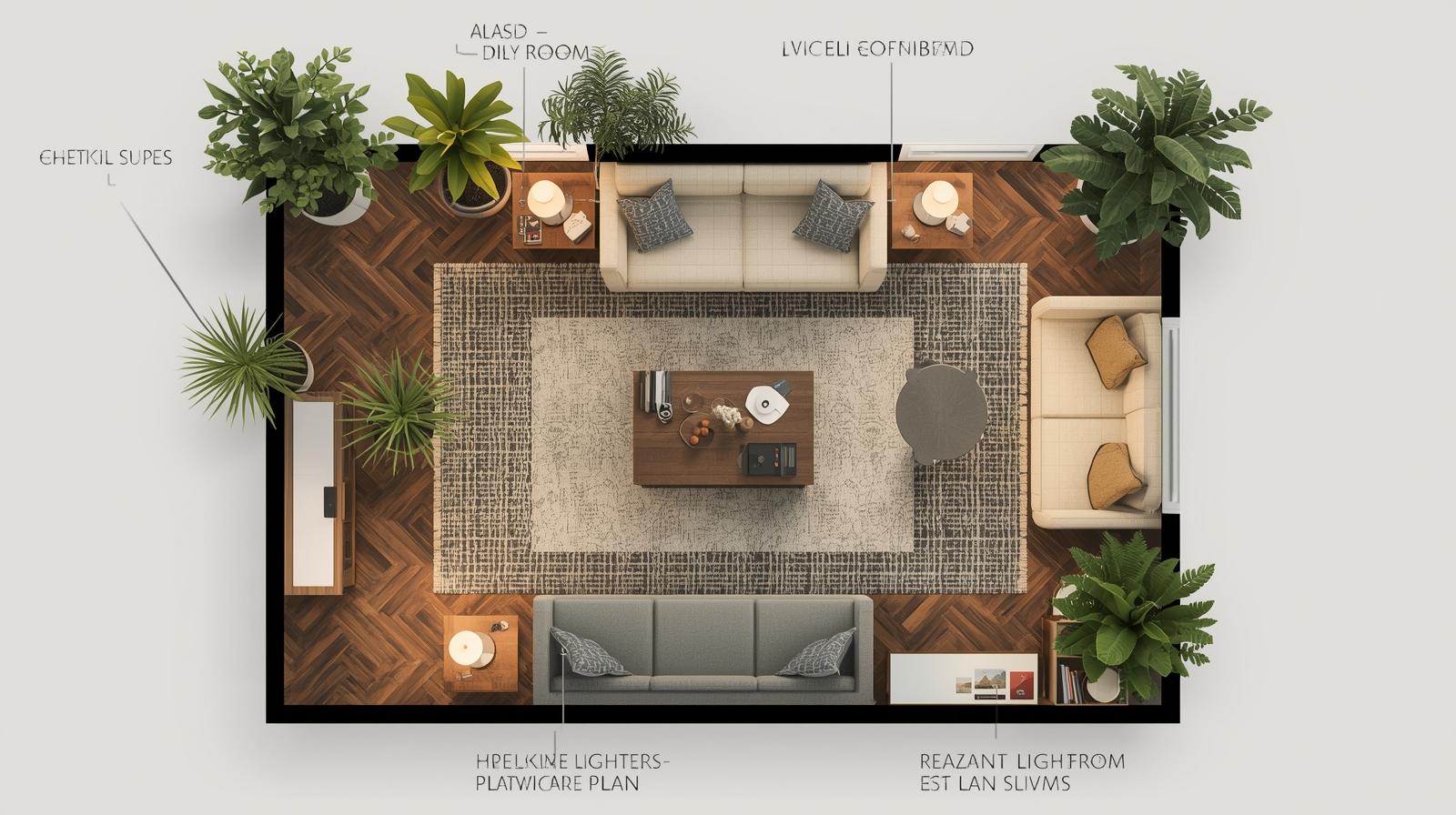
Pain Point Solved: Many readers struggle with undefined open spaces this strategy gives the room cohesion and functionality.
Step 3: Building Your Foundational Palette
Color is one of the first things people feel when they walk into a room. In Organic Modern interiors, the palette is calming, warm, and rooted in the earth.
- Core Neutrals: Think warm whites, greige, taupe, or soft clay. These work for walls, sofas, curtains, and large furniture.
- Subtle Accents: Add personality through muted, organic tones like terracotta, sage green, or charcoal in your accessories or art.
🎨 Design Tip: Keep your base neutral and add color in the smallest 20% of your visual space like throw pillows, art, or pottery for a timeless feel.
Step 4: Layering Textures & Natural Elements
Texture is where your Organic Modern room comes alive.
- Mix materials with intention: linen, rattan, wool, oak, and stone.
- Vary between soft and structured: pair a fluffy wool pillow with a leather pouf or a raw-edge wood table with a smooth ceramic vase.
Integrating Biophilia
Nature doesn’t just inspire Organic Modern it is the heart of it. Add greenery not just for decoration, but to improve air quality and mood.
- Use larger plants (like a fiddle leaf fig) for structure.
- Layer smaller plants (pothos, snake plant, rubber tree) at different heights.
🌿 Placement Tip: Put plants near windows, beside low furniture, or on open shelving to balance negative space with life and texture.
Step 5: Curating Art & Personal Touches
This is where your space becomes truly yours. Avoid cookie-cutter decor and opt for meaningful, curated pieces that reflect who you are.
- Choose art that speaks to you be it abstract landscapes, hand-drawn line art, or nature-based photography.
- Decorative accents like handmade ceramics, heirloom pieces, or vintage finds lend authenticity and soul.
💡 Expert Tip: Less is more. Showcase fewer pieces with more impact. One well-placed ceramic bowl or a gallery of framed sketches can say more than a shelf full of filler.
🧠 Pain Point Solved: Many people love the Organic Modern style but feel it looks “too styled.” Personal touches bridge that gap between trend and individuality.
DIY & Personalization Checklist
Consistency doesn’t require a degree in design. Use this simple checklist to stay on track while still expressing your unique vision:
✅ Have I balanced clean lines with organic forms?
✅ Is there a thoughtful mix of soft and hard textures?
✅ Are natural materials like wood, linen, and stone prominent?
✅ Is there enough negative space to create calm and visual breathing room?
✅ Does the color palette feel cohesive and grounding?
✅ Have I added items that reflect my personal style, values, or story?
✨ Design Formula Shortcut:
Neutral base + natural texture + personal touches + open space = effortless Organic Modern.
Overcoming Design Challenges in Organic Modern Spaces
Even the most visually soothing styles can come with practical hurdles. While Organic Modern design champions calm, clarity, and nature-driven beauty, real-world living open layouts, tight quarters, legacy furniture can test your styling skills. The good news? With a few smart strategies, you can overcome these challenges without sacrificing the look or feel of your space.
Challenge 1: Decorating Open-Concept Living Rooms
The Problem:
Open-concept layouts offer spaciousness and flow but without walls, rooms can feel cavernous, undefined, or chaotic.
The Solution:
- Define Distinct Zones: Use large area rugs to visually anchor seating or dining spaces. This immediately tells the eye, this is where the conversation happens.
- Furniture Arrangement: Angle or cluster seating inward to create a focal point, like around a coffee table or facing a fireplace or artwork.
- Layer Lighting: Install pendant lights over dining zones, floor lamps in reading corners, or table lamps in lounging areas to distinguish function through ambiance.
- Add Vertical Breaks: Use tall plants (like a fiddle leaf fig), open shelving, or screens to subtly create separation without walls.
Expert Tip: Don’t be afraid of asymmetry. Organic Modern thrives on balance not strict perfection so let your zones feel natural and slightly fluid.
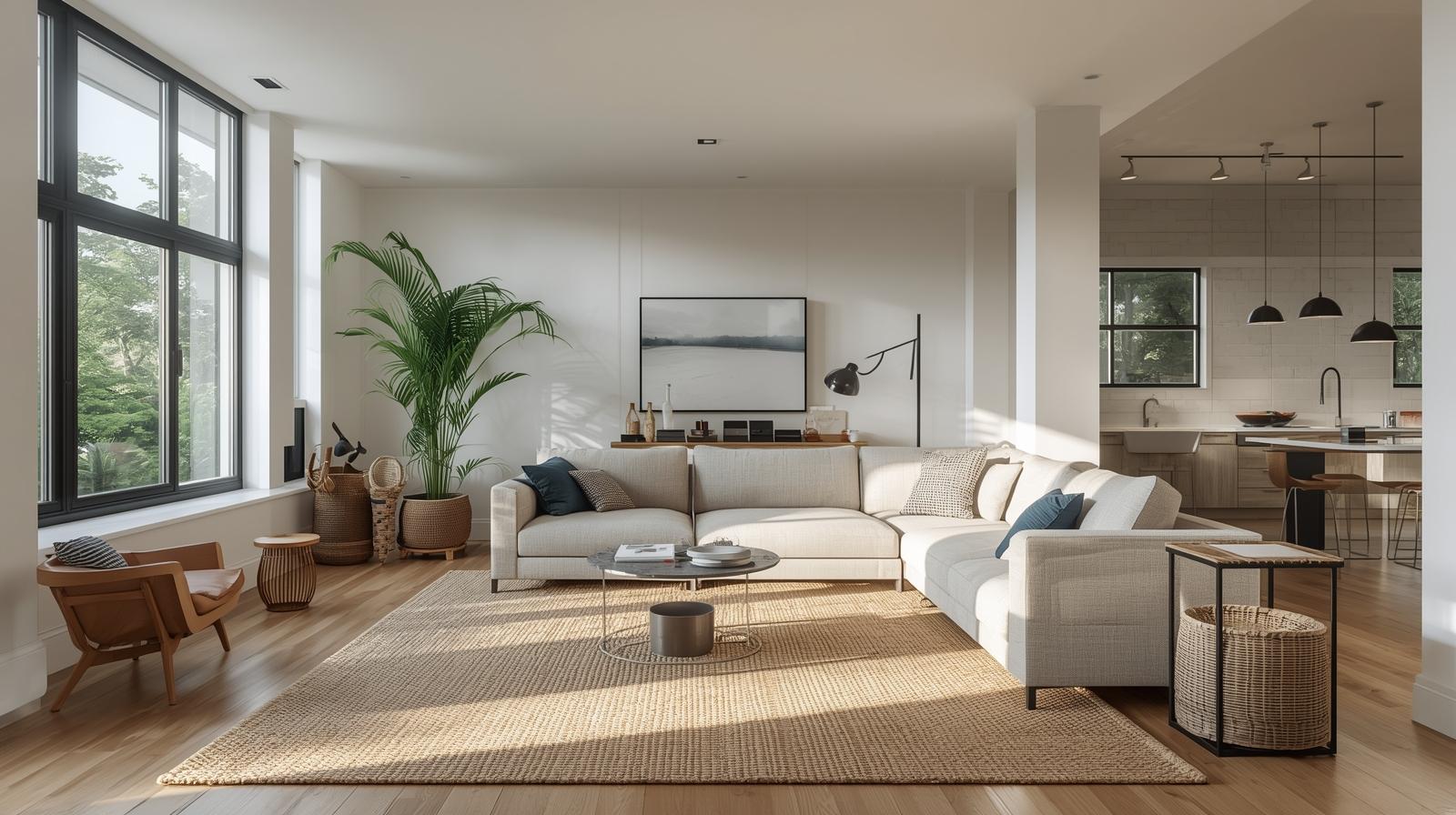

Costa Farms Fiddle Leaf Fig

nuLOOM 6x9 Rigo Jute

Maximizing Small Living Rooms
Integrating Existing Furniture
The Problem:
Not everyone starts from scratch and that’s okay. The challenge lies in blending older or non-organic modern pieces into your newly refined space without throwing off the aesthetic.
The Solution:
- Reupholster or Refinish: Give dated furniture a fresh start by covering it in natural linen, cotton, or wool. For wooden pieces, consider light sanding and a matte finish or limewash for a softer, organic feel.
- Strategic Placement: If a piece doesn’t perfectly align with the style, place it where it’s functional but not the focal point like a reading nook or behind the sofa.
- Cohesive Styling: Layer Organic Modern decor around older pieces like placing a textured wool throw over a traditional chair or styling a rustic coffee table with modern vases and books to visually tie everything together.
- Mix with Confidence: Remember, Organic Modern celebrates imperfection. A mix of new and old adds story and character just ensure materials and tones harmonize.
💡 Mindset Tip: Don’t view older pieces as design blocks they’re opportunities to tell your story within the space.
Challenge 4: Balancing Functionality & Aesthetics
The Problem:
How do you maintain the elegance of Organic Modern design in a high-traffic, real-life living room especially one that serves as a family hub, work zone, or gathering spot?
The Solution:
- Choose Practical Materials: Opt for performance-grade fabrics like high-quality linen blends, stain-resistant cotton, or microfiber in natural hues. For wood surfaces, look for sealed finishes or naturally durable species like oak or teak.
- Smart Layouts: Leave clear walkways (minimum 30–36 inches wide), and orient furniture to avoid collisions and bottlenecks.
- Hidden Storage: Use furniture with built-in storage coffee tables with drawers, media consoles with cabinets, or benches with lift-up tops. This lets you hide clutter while maintaining a clean aesthetic.
- Durable Decor: Choose accessories that are both pretty and practical like ceramic bowls for keys or woven baskets for blankets and toys.
💡 Expert Tip: Don’t feel like you have to compromise beauty for function. In Organic Modern design, the best pieces are often the ones that do both effortlessly.
Smart & Sustainable Organic Modern Design
Creating an Organic Modern living room that feels serene, stylish, and soulful doesn’t have to mean overspending or compromising your values. In fact, the very spirit of Organic Modern design embraces thoughtfulness, longevity, and conscious choices not just in aesthetics, but in how we shop, what we bring into our homes, and how those decisions impact both our well being and the planet.
Budget vs. Splurge: Smart Shopping Tips
Invest Wisely
When working with a budget, the key is knowing where to spend and where to save. Your most-used pieces are worth the investment.
- Anchor Pieces First: Prioritize sofas, lounge chairs, and coffee tables. These foundational elements not only dictate your space’s layout but also carry the brunt of everyday use.
- Material Matters: Opt for solid wood frames, high-density cushions, and natural performance fabrics that can withstand time and trends.
Expert Tip: If you’re going to splurge, do it on the sofa. It sets the tone for the room and should offer both style and support for years to come.
- A plush linen-blend sectional with a kiln-dried hardwood frame.
- A handcrafted oak coffee table with natural finishes.
Save Smart
Not everything needs to break the bank. For lower-impact items, get creative and stay flexible.
- Accessories & Decor: Throw pillows, vases, trays, and art can all be budget-friendly especially when swapped seasonally or layered over time.
- DIY Friendly: These smaller pieces offer the perfect opportunity to express your creativity through budget-friendly crafts or up cycled finds.
- Look for Deals: Watch for sales on home sites, explore clearance aisles, and sign up for alerts on flash sale platforms.
Pro Tip: Don’t overlook hardware stores, art supply shops, and local makers’ markets treasures are often hiding where you least expect them.
Thrifted, Vintage & DIY: Sustainable Style on a Budget
One of the most fulfilling paths to Organic Modern beauty is through intentional second-hand sourcing. Vintage and pre-loved pieces add soul and sustainability to your home and they’re often one-of-a-kind.
Second-Hand Shopping
- Thrift Stores & Antique Shops: These are goldmines for character-rich, often better-made furniture at a fraction of the price.
- Online Marketplaces: Sites like Facebook Marketplace, Offer Up, Chairish, or local resale groups can yield high-quality finds with a little patience.
Curated Finds: Look for solid wood frames, handwoven rugs, and original art items that lend a story to your space.
Don’t try to make everything match. Organic Modern thrives on collected elegance, where each piece feels curated over time.
Easy DIY Upgrades
Personalizing your space doesn’t require professional skills just a little creativity and a willingness to experiment.
- Paint It Fresh: A quick coat of paint on an old dresser or coffee table in a warm neutral (e.g., clay beige, sage green) can make it feel brand new.
- Wall Art on a Budget: Try painting your own abstract canvas using earthy tones and organic shapes.
- DIY Decor: Craft simple touches like macrame plant hangers, clay candle holders, or hand-pressed botanical prints.
🎨 Bonus: DIY projects allow you to inject personal meaning into your home something money can’t always buy.
Designing with a Conscience: Sustainability in Organic Modern
A truly Organic Modern space does more than look good it feels responsible. With sustainability at its core, this design ethos calls for mindful sourcing, ethical production, and long-term durability.
Choose Eco-Friendly Materials
Look for products made from:
- Rapidly renewable resources: Like bamboo, cork, or rattan.
- Recycled or upcycled elements: Reclaimed wood, recycled metal, or reused textiles.
- Non-toxic finishes and dyes: For cleaner air and healthier indoor environments.
🌿 Example: A jute rug with natural dye and a rubber backing made from recycled materials.
Support Ethical Brands
More homeowners are asking: Where did this come from, and who made it?
- Choose companies that transparently share their supply chains and use ethical labor practices.
- Look for brands that give back to communities or invest in sustainable innovation.
🛒 Certification to watch for:
- FSC (Forest Stewardship Council) for responsibly sourced wood.
- GOTS (Global Organic Textile Standard) for organic fabrics.
- Fair Trade Certified for ethically made home goods.
Prioritize Longevity
The most sustainable product? One you don’t have to replace.
- Buy less, choose better. Focus on versatility, craftsmanship, and classic lines over fast-furniture trends.
- Regular care (like oiling wood or spot-cleaning fabric) extends the life of what you own.
💡 Expert Tip: Think beyond this year. A timeless Organic Modern piece should still feel relevant and function well five or ten years from now.
Local & Handmade Pieces
Locally made goods reduce your carbon footprint and often carry more meaning than mass-produced alternatives.
- Support local artisans and makers through fairs, independent boutiques, or direct-to-customer sites like Etsy or Faire.
- Consider hand-thrown pottery, woven baskets, or small-batch textiles to layer your space with authenticity.
Bringing Your Vision to Life: Final Touches & Inspiration
At this stage, your Organic Modern living room is more than just a styled space it’s a reflection of your values, your rhythm, and your vision. But there’s still one final layer to consider: how your design choices influence your well-being, comfort, and everyday experience. That’s where true transformation happens not just in how your space looks, but in how it makes you feel.
Creating a Wellness-Focused Sanctuary
Organic Modern design has always emphasized connection to nature, to self, and to intentional living. A wellness-focused sanctuary takes this a step further, blending beauty with function to create a home that nourishes your body and mind.
1. Natural Light
Letting daylight flood your space is one of the most impactful design decisions you can make.
- Mood Boosting: Exposure to natural light has been shown to improve sleep, mood, and productivity.
- Design Tip: Use sheer curtains, light-reflective wall colors (like warm whites or soft taupes), and strategically placed mirrors to maximize natural light flow.
2. Plants: Your Living Decor
Bringing greenery indoors adds more than just visual softness it actively enhances your environment.
- Air Purification: Many houseplants filter toxins and improve air quality.
- Mindfulness Connection: Tending to plants encourages slow living and presence.
- Top Picks for Organic Modern Spaces: Snake plant, rubber plant, olive tree, and pothos for easy care and elegant structure.
🌱 Pro Tip: Use clay or stone planters in neutral tones to align with your overall palette and texture scheme.
3. A Calming Color Palette
The power of a well-chosen color palette goes far beyond visual appeal it can significantly influence your mood.
- Keep It Soft: Stick with earthy neutrals, soft greens, and muted clay tones.
- Avoid Overstimulation: Minimize harsh contrasts or overly saturated hues, which can disrupt the calm ambiance Organic Modern is known for.
- Design Rule of Thumb: Use the 60-30-10 rule: 60% main color (e.g., walls and large furniture), 30% secondary (e.g., rugs, curtains), and 10% accents (e.g., art, accessories).
4. Comfort & Hygge Elements
At the heart of any sanctuary is comfort but not in the cluttered, overstuffed sense. Think warmth, tactility, and intentional softness.
- Layer Soft Textures: Add throws, knitted pillows, wool rugs, and draped fabrics to bring in warmth and tactile variety.
- Inviting Seating Areas: Create cozy zones with plush chairs, window nooks, or floor cushions for relaxation, meditation, or reading.
- Scent Matters: Use subtle, natural scents (e.g., eucalyptus, cedar, or lavender) via essential oil diffusers or beeswax candles.
🕯️ Wellness Tip: Scent is deeply tied to memory and emotion using natural aromatherapy can reinforce a sense of peace and routine in your space.
The Power of Lighting: Enhancing Mood and Ambiance
Lighting is the invisible design hero of any well-composed room. It defines mood, changes functionality, and brings your Organic Modern vision to life especially as the sun sets.
Layering Light for Balance
A truly functional and emotionally resonant lighting plan should include all three layers:
- Ambient Lighting: This is your base layer overhead lights or large-scale fixtures that evenly illuminate the room.
- Task Lighting: Focused lighting for activities like reading, working, or dining. Think: floor lamps by chairs or desk sconces.
- Accent Lighting: Use spotlights, wall sconces, or candles to highlight art, textures, or architectural features.
💡 Expert Tip: Lighting temperature matters. Choose warm white (2700–3000K) bulbs to promote relaxation and replicate natural dusk tones.
Embracing Smart Lighting Solutions
Today’s smart home tech makes ambiance easily customizable without sacrificing your organic aesthetic.
- Dimmers: Control brightness to transition from day to night seamlessly.
- Smart Bulbs & Plugs: Set schedules, adjust colors, or dim lights via app or voice ideal for winding down or energizing your mornings.
- Sustainable LED Options: Choose energy-efficient bulbs in your lighting plan to support both eco-consciousness and longevity.
Conclusion & Next Steps
Recapping Your Organic Modern Journey
You’ve just walked through a complete transformation not just of a space, but of a mindset. Throughout this guide, we’ve explored how Organic Modern design balances calm simplicity with rich, grounded detail. From shaping your vision and building a tactile, nature-infused palette to overcoming layout challenges and embracing sustainable practices, you now hold the tools to create a home that feels as good as it looks.
Whether you’re in the early planning stages or already moving furniture, this style isn’t about perfection it’s about creating a space that feels authentic to you.
Key Takeaways
- Start with clarity: Define your mood board and core style direction.
- Think naturally: Use real wood, linen, wool, stone, and clay for warmth and honesty.
- Layer with intention: Combine soft and hard textures, organic forms, and clean lines.
- Let light lead: Maximize natural light, and build a thoughtful lighting plan.
- Stay personal: Add art, objects, and furniture that reflect your story.
- Be mindful: Choose sustainable, durable, and ethically sourced pieces when possible.
Your Next Steps to a Serene Space
Designing an Organic Modern living room isn’t something you need to do all at once. It’s a journey and one that’s meant to evolve with time, creativity, and self-expression.
Start Small
Pick one principle that resonated most maybe it’s swapping in a natural fiber rug, rearranging furniture to create better flow, or simply gathering inspiration with a digital mood board.
Remember: Even a single design decision rooted in intention can shift the energy of your entire space.
✅ Apply What You’ve Learned
Don’t overthink it. Begin with one corner or one piece. A new color palette, a thrifted ceramic vase, a layered lighting setup each step brings you closer to a sanctuary that reflects your rhythm and priorities.

